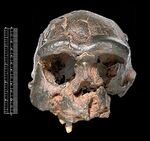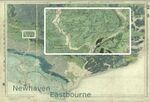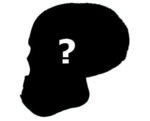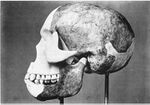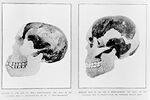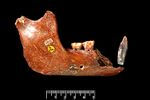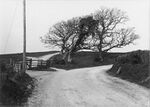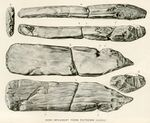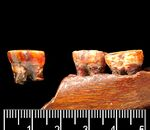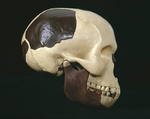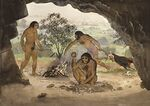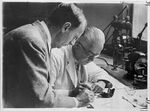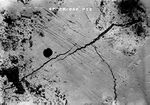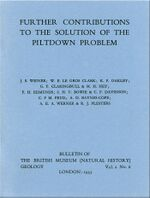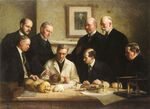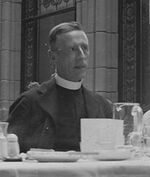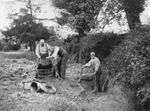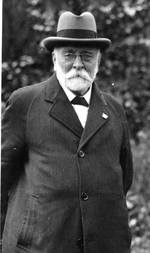Piltdown Man forgery: Difference between revisions
No edit summary |
No edit summary |
||
| (16 intermediate revisions by the same user not shown) | |||
| Line 3: | Line 3: | ||
[[File:Piltdown 001.jpg|thumb|Piltdown, Sussex, England, is marked by the red dot. © BGS/NERC Public domain]] | [[File:Piltdown 001.jpg|thumb|Piltdown, Sussex, England, is marked by the red dot. © BGS/NERC Public domain]] | ||
== Introduction == | == Introduction == | ||
At a meeting of the Geological Society of London, in December 1912, the fossil remains of what was claimed to be a new type of early human, Eoanthropus dawsoni, or ‘Piltdown Man’, were unveiled to the world. | At a meeting of the Geological Society of London, in December 1912, the fossil remains of what was claimed to be a new type of early human, ''Eoanthropus dawsoni'', or ‘Piltdown Man’, were unveiled to the world. | ||
It appeared that irrefutable evidence had at last been found for the much sought-after ‘missing link’ between man and ape. | It appeared that irrefutable evidence had at last been found for the much sought-after ‘missing link’ between man and ape. | ||
| Line 11: | Line 11: | ||
== Contribution and collaboration == | == Contribution and collaboration == | ||
Staff of the [ | Staff of the [https://www.nhm.ac.uk/ Natural History Museum] (previously the British Museum (Natural History)), the [https://www.geolsoc.org.uk/ Geological Society], and the British Geological Survey (previously H.M. Geological Survey) were all involved with Piltdown — from discovery to unmasking. Some have been implicated in the forgery itself. | ||
Archivists at the Natural History Museum, the Geological Society and the British Geological Survey have pooled their resources to create a web-based exhibition telling the story of Piltdown Man’s discovery. | Archivists at the Natural History Museum, the Geological Society and the British Geological Survey have pooled their resources to create a web-based exhibition telling the story of Piltdown Man’s discovery. | ||
The | The timeline reveals the history of the forgery and the identity of the individuals accused of complicity or culpability in the affair. | ||
The Piltdown story provides a cautionary lesson on how scientists can get things wrong and how science, when applied correctly, can reveal error and malpractice. | The Piltdown story provides a cautionary lesson on how scientists can get things wrong and how science, when applied correctly, can reveal error and malpractice. | ||
| Line 126: | Line 126: | ||
| style="vertical-align:top;" | Dawson the ‘Wizard’ produces ‘Piltdown II’ | | style="vertical-align:top;" | Dawson the ‘Wizard’ produces ‘Piltdown II’ | ||
| style="vertical-align:top;" | On 9 January 1915,Dawson wrote to Smith Woodward; ‘I believe weare in luck again! I have got a fragment of the left side of a frontal bone with portion of the orbit and root of nose... the general thickness seems to me to correspond to the right parietal of ''Eoanthropus''’.Dawson omitted to mention the location of his find, noting only that it came from a ploughed field (Smith Woodward appears however to have been aware of the general location). | | style="vertical-align:top;" | On 9 January 1915,Dawson wrote to Smith Woodward; ‘I believe weare in luck again! I have got a fragment of the left side of a frontal bone with portion of the orbit and root of nose... the general thickness seems to me to correspond to the right parietal of ''Eoanthropus''’. Dawson omitted to mention the location of his find, noting only that it came from a ploughed field (Smith Woodward appears however to have been aware of the general location). | ||
| style="vertical-align:top;" | [[File:Piltdown 018.jpg|150px|Charles Dawson (left) and Arthur Smith Woodward (middle) sifting gravel at Barkham Manor in the summerof 1913; Venus Hargreaves (right) was employed as labourer From ''Natural History: Journal of the American Museum'', Nov-Dec 1921]] | | style="vertical-align:top;" | [[File:Piltdown 018.jpg|150px|Charles Dawson (left) and Arthur Smith Woodward (middle) sifting gravel at Barkham Manor in the summerof 1913; Venus Hargreaves (right) was employed as labourer From ''Natural History: Journal of the American Museum'', Nov-Dec 1921]] | ||
|- | |- | ||
| Line 193: | Line 193: | ||
| style="vertical-align:top;" | Britain’s first geological National Nature Reserve | | style="vertical-align:top;" | Britain’s first geological National Nature Reserve | ||
| style="vertical-align:top;" | The National Parks and Access to the Countryside Act of 1949 saw the creation of | | style="vertical-align:top;" | The National Parks and Access to the Countryside Act of 1949 saw the creation of a government body, the Nature Conservancy, a forerunner of Natural England. Its aim was to identify and protect Britain’s most important fauna, flora, geological and physiographical features. The Piltdown Skull Site at Barkham Manor was one of the first sites to be considered for acquisition and listing as a National Nature Reserve (NNR). The site was acquired by the Nature Conservancy on 3 December 1951, and formally declared a NNR on 19 May 1952. Although just beaten in the race to become the nation’s first NNR by a site in Scotland, Piltdown would soon earn notoriety as the first NNR to be revoked! | ||
| style="vertical-align:top;" | [[File:Piltdown 028.jpg|150px| The Piltdown Skull Site taken at its peak on 16 April 1952, just prior to its declaration as a National Nature Reserve (NNR). © Natural England]] | | style="vertical-align:top;" | [[File:Piltdown 028.jpg|150px| The Piltdown Skull Site taken at its peak on 16 April 1952, just prior to its declaration as a National Nature Reserve (NNR). © Natural England]] | ||
|- | |- | ||
| Line 203: | Line 203: | ||
| style="vertical-align:top;" | 1953 | | style="vertical-align:top;" | 1953 | ||
| style="vertical-align:top;" | A forgery uncovered | | style="vertical-align:top;" | A forgery uncovered | ||
| style="vertical-align:top;" | Weiner became convinced that the teeth in the jaw had been filed down and | | style="vertical-align:top;" | Weiner became convinced that the teeth in the jaw had been filed down and this indicated deliberate fraud. He obtained some chimpanzee teeth which he filed down and stained artificially in order to replicate the Piltdown molars. After discussing it with Wilfrid Le Gros Clark, Professor of Anatomy at Oxford, it was decided to contact Kenneth Oakley at the Natural History Museum and inform him of their suspicions. Oakley checked the teeth and was ‘utterly convinced’ that they had been artificially abraded. Further examination revealed that the canine tooth had been stained using a mixture which included Vandyke brown paint. | ||
| style="vertical-align:top;" | [[File:Piltdown 030.jpg|150px|Scanning electron microscope view of molar surface showing scratch marks. © Natural History Museum (Image: 039913)]] | | style="vertical-align:top;" | [[File:Piltdown 030.jpg|150px|Scanning electron microscope view of molar surface showing scratch marks. © Natural History Museum (Image: 039913)]] | ||
|- | |- | ||
| Line 217: | Line 217: | ||
| style="vertical-align:top;" | Arthur Keith accepts the truth | | style="vertical-align:top;" | Arthur Keith accepts the truth | ||
| style="vertical-align:top;" | On the day of the press release, Oakley and Weiner visited Arthur Keith, who was now well into his eighties. On being appraised of their findings, Keith replied ‘You may be right, Weiner, and I must accept it, but it will take me a little while to adjust to it.’ On 28 November Pierre Teilhard de Chardin | | style="vertical-align:top;" | On the day of the press release, Oakley and Weiner visited Arthur Keith, who was now well into his eighties. On being appraised of their findings, Keith replied ‘You may be right, Weiner, and I must accept it, but it will take me a little while to adjust to it.’ On 28 November Pierre Teilhard de Chardin wrote to Oakley from New York congratulating him on his solution of the Piltdown problem:‘Anatomically speaking, “''Eoanthropus''” was a kind of monster... Therefore I am fundamentally pleased by your conclusions, in spite of the fact that, sentimentally speaking, it spoils one of my brightest and earliest palaeontological memories.’ | ||
| style="vertical-align:top;" | [[File:Piltdown 032.jpg|150px|The solution of the Piltdown Problem, Weiner et al., 1953. © BGS/NERC reproduction.]] | | style="vertical-align:top;" | [[File:Piltdown 032.jpg|150px|The solution of the Piltdown Problem, Weiner et al., 1953. © BGS/NERC reproduction.]] | ||
|- | |- | ||
| Line 224: | Line 224: | ||
| style="vertical-align:top;" | Confirmation of the fraud | | style="vertical-align:top;" | Confirmation of the fraud | ||
| style="vertical-align:top;" | Over a period of several months the Piltdown remains were subjected to further tests. A full presentation of the scientific results was made at a meeting of the Geological Society on | | style="vertical-align:top;" | Over a period of several months the Piltdown remains were subjected to further tests. A full presentation of the scientific results was made at a meeting of the Geological Society on 30 June 1954. The Piltdown jaw and canine were confirmed as being from a modern ape, probably a young female orangutan. The exceptional thickness of the skull (essentially that of a modern human) might be explained as a pathological condition, although such thickened crania are met with in some modern populations. | ||
| style="vertical-align:top;" | [[File:Piltdown 033.jpg|150px|A full presentation of the scientific results was made at a meeting of the Geological Society on 30 June 1954. © Natural History Museum (Image: 006967)]] | | style="vertical-align:top;" | [[File:Piltdown 033.jpg|150px|A full presentation of the scientific results was made at a meeting of the Geological Society on 30 June 1954. © Natural History Museum (Image: 006967)]] | ||
|- | |- | ||
| Line 258: | Line 258: | ||
| style="vertical-align:top;" | 1953 | | style="vertical-align:top;" | 1953 | ||
| style="vertical-align:top;" | Charles Dawson (1864-1916) | | style="vertical-align:top;" | Charles Dawson (1864-1916) | ||
| style="vertical-align:top;" | Dawson was a solicitor at Uckfield in Sussex, and a noted antiquarian and amateur geologist, | | style="vertical-align:top;" | Dawson was a solicitor at Uckfield in Sussex, and a noted antiquarian and amateur geologist, having been elected a Fellow of the Geological Society of London in 1885 and of the Society of Antiquaries in 1895. He made many donations of Wealden fossils to the Natural History Museum. Dawson was ambitious for recognition and fame and fully expected the Piltdown discoveries to secure him fellowship of the Royal Society, an aspiration that was ultimately denied him. When the fraud was exposed in 1953, Dawson became an obvious suspect. He had been the motivating force behind the excavations and was always present when finds were made. Following his death in 1916 there were no further discoveries. Since 1953 many of Dawson’s antiquarian ‘discoveries’ have been shown to be either fraudulent or suspect. | ||
| style="vertical-align:top;" | [[File:Piltdown 038.jpg|150px|Charles Dawson © The Geological Society (GSL/POR/49/17-01)]] | | style="vertical-align:top;" | [[File:Piltdown 038.jpg|150px|Charles Dawson © The Geological Society (GSL/POR/49/17-01)]] | ||
|- | |- | ||
| style="vertical-align:top;" | 1954 | | style="vertical-align:top;" | 1954 | ||
| style="vertical-align:top;" | Pierre Teilhard de Chardin (1881–1955) | | style="vertical-align:top;" | Pierre Teilhard de Chardin (1881–1955) | ||
| style="vertical-align:top;" | Teilhard de Chardin was a French philosopher and Jesuit priest who trained as a palaeontologist. He was studying at Hastings when he first met Dawson in 1909. Dawson invited him to the excavation at Piltdown in 1912, and in 1913 Teilhard discovered the canine tooth. He was still alive when the | | style="vertical-align:top;" | Teilhard de Chardin was a French philosopher and Jesuit priest who trained as a palaeontologist. He was studying at Hastings when he first met Dawson in 1909. Dawson invited him to the excavation at Piltdown in 1912, and in 1913 Teilhard discovered the canine tooth. He was still alive when the fraud was uncovered, but when questioned was reluctant to talk about it, which in 1954 aroused suspicion in the minds of the investigators. Those who have implicated Teilhard include Louis Leakey and Stephen Jay Gould, both of whom believed it possible that he had worked in collusion with Dawson. Leakey had no clear evidence to back up his suspicion, while Gould’s accusation was based on incomplete information. More recently the case against Teilhard has been revived by Francis Thackeray, who believes that Teilhard perpetrated a prank that went too far. | ||
| style="vertical-align:top;" | [[File:Piltdown 039.jpg|150px|Teilhard de Chardin at lunch with colleagues at the Natural History Museum in 1935. © Natural History Museum (Image: 046939)]] | | style="vertical-align:top;" | [[File:Piltdown 039.jpg|150px|Teilhard de Chardin at lunch with colleagues at the Natural History Museum in 1935. © Natural History Museum (Image: 046939)]] | ||
|- | |- | ||
| style="vertical-align:top;" | 1972 | | style="vertical-align:top;" | 1972 | ||
| style="vertical-align:top;" | William Ruskin Butterfield (1872–1935) | | style="vertical-align:top;" | William Ruskin Butterfield (1872–1935) | ||
| style="vertical-align:top;" | Butterfield was curator and librarian of Hastings Museum during the period of the Piltdown discoveries. In 1972 Guy van Esbroeck, in his book Pleine lumière sur l’imposture de Piltdown, accused Butterworth of being the Piltdown forger in collusion with Venus Hargreaves, the labourer employed at Barkham Manor. His argument is that Butterworth was greatly put out on learning through a chance remark from Teilhard de Chardin, in 1909, that Dawson had quietly appropriated a series of bones of the dinosaur Iguanodon from a Hastings quarry and presented them to the Natural History Museum at South Kensington. It is claimed that | | style="vertical-align:top;" | Butterfield was curator and librarian of Hastings Museum during the period of the Piltdown discoveries. In 1972 Guy van Esbroeck, in his book ''Pleine lumière sur l’imposture de Piltdown'', accused Butterworth of being the Piltdown forger in collusion with Venus Hargreaves, the labourer employed at Barkham Manor. His argument is that Butterworth was greatly put out on learning through a chance remark from Teilhard de Chardin, in 1909, that Dawson had quietly appropriated a series of bones of the dinosaur ''Iguanodon'' from a Hastings quarry and presented them to the Natural History Museum at South Kensington rather than to Hastings Museum. It is claimed that Butterfield carried out the ‘hoax’ in revenge. This theory seems to ignore the fact that Dawson had already made his first find at Piltdown probably in the previous year, 1908. | ||
| style="vertical-align:top;" | | | style="vertical-align:top;" | | ||
|- | |- | ||
| style="vertical-align:top;" | 1972 | | style="vertical-align:top;" | 1972 | ||
| style="vertical-align:top;" | Venus Hargreaves (dates unknown) | | style="vertical-align:top;" | Venus Hargreaves (dates unknown) | ||
| style="vertical-align:top;" | Hargreaves was the labourer who did most of the digging at Piltdown. Apart from van Esbroeck’s assertion that Hargreaves assisted Butterfield by planting the fraudulent Piltdown assemblage (previous | | style="vertical-align:top;" | Hargreaves was the labourer who did most of the digging at Piltdown. Apart from van Esbroeck’s assertion that Hargreaves assisted Butterfield by planting the fraudulent Piltdown assemblage (previous entry), Francis Vere had earlier intimated in his book ''The Piltdown Fantasy'' (1955) that the forger required an accomplice who worked at the site, by which he presumably meant Hargreaves. | ||
| style="vertical-align:top;" | [[File:Piltdown 040.jpg|150px|Charles Dawson (left) and Arthur Smith Woodward (middle) sifting gravel at Barkham Manor in the summer of 1913; Venus Hargreaves (right) was employed as labourer | | style="vertical-align:top;" | [[File:Piltdown 040.jpg|150px|Charles Dawson (left) and Arthur Smith Woodward (middle) sifting gravel at Barkham Manor in the summer of 1913; Venus Hargreaves (right) was employed as labourer From ''Natural History: Journal of the American Museum'', Nov-Dec 1921]] | ||
|- | |- | ||
| style="vertical-align:top;" | 1972 | | style="vertical-align:top;" | 1972 | ||
| style="vertical-align:top;" | Grafton Elliot Smith (1871-1937) | | style="vertical-align:top;" | Grafton Elliot Smith (1871-1937) | ||
| style="vertical-align:top;" | Elliot Smith, born at Grafton in Australia, was Professor of Anatomy at University of Manchester, 1909–19, and University College London, 1919–37, and had a special interest in the anatomy of the human brain. In The Piltdown Men (1972) Ronald Millar accused Smith of perpetrating the forgery in order to provide support for his views on human evolution. The case made against him is convoluted and entirely circumstantial. Millar regards it as suspicious that Smith allowed Woodward to reconstruct the Piltdown skull incorrectly, as Smith was an expert on prehistoric human skulls. One is prompted to ask why, if implicated in the fraud, did Smith assist Woodward in his continuing attempts to look for further evidence at Piltdown long after Dawson’s death? Kenneth Oakley (in a private communication to Charles Blinderman) regarded Millar’s accusation as ‘absurd’, a view shared by many others. | | style="vertical-align:top;" | Elliot Smith, born at Grafton in Australia, was Professor of Anatomy at University of Manchester, 1909–19, and University College London, 1919–37, and had a special interest in the anatomy of the human brain. In ''The Piltdown Men'' (1972) Ronald Millar accused Smith of perpetrating the forgery in order to provide support for his views on human evolution. The case made against him is convoluted and entirely circumstantial. Millar regards it as suspicious that Smith allowed Woodward to reconstruct the Piltdown skull incorrectly, as Smith was an expert on prehistoric human skulls. One is prompted to ask why, if implicated in the fraud, did Smith assist Woodward in his continuing attempts to look for further evidence at Piltdown long after Dawson’s death? Kenneth Oakley (in a private communication to Charles Blinderman) regarded Millar’s accusation as ‘absurd’, a view shared by many others. | ||
| style="vertical-align:top;" | | | style="vertical-align:top;" | | ||
|- | |- | ||
| style="vertical-align:top;" | 1978 | | style="vertical-align:top;" | 1978 | ||
| style="vertical-align:top;" | William Johnson Sollas (1849-1936) | | style="vertical-align:top;" | William Johnson Sollas (1849-1936) | ||
| style="vertical-align:top;" | Sollas was Professor of Geology at Oxford. In 1978 he was accused of complicity in the Piltdown forgery by his former assistant at the university, Prof. J. A. Douglas (died 1978). Douglas was convinced that Sollas had directed the hoax through Dawson in order to revenge himself on Smith Woodward, who he regarded as a bitter enemy. Douglas’s evidence consisted of nothing more than his memory of the arrival of a package for Sollas containing potassium ‘bichromate’, and of Sollas borrowing apes’ teeth from the university’s Department of Human Anatomy. According to Douglas the whole thing had ‘started as a joke and then got out of hand’. It has been suggested that Douglas may have harboured a grudge against Sollas, who un-obligingly retained his professorship to the age of 87 before yielding the Chair to Douglas. | | style="vertical-align:top;" | Sollas was Professor of Geology at Oxford. In 1978 he was accused of complicity in the Piltdown forgery by his former assistant at the university, Prof. J. A. Douglas (died 1978). Douglas was convinced that Sollas had directed the 'hoax' through Dawson in order to revenge himself on Smith Woodward, who he regarded as a bitter enemy. Douglas’s evidence consisted of nothing more than his memory of the arrival of a package for Sollas containing potassium ‘bichromate’, and of Sollas borrowing apes’ teeth from the university’s Department of Human Anatomy. According to Douglas the whole thing had ‘started as a joke and then got out of hand’. It has been suggested that Douglas may have harboured a grudge against Sollas, who un-obligingly retained his professorship to the age of 87 before yielding the Chair to Douglas. | ||
| style="vertical-align:top;" | [[File:Piltdown 041.jpg|150px|Portrait of William Johnson Sollas. Black and white photograph by Hills & Saunders, 1915. ©Geological Society GSL/POR/57/34]] | | style="vertical-align:top;" | [[File:Piltdown 041.jpg|150px|Portrait of William Johnson Sollas. Black and white photograph by Hills & Saunders, 1915. ©Geological Society GSL/POR/57/34]] | ||
|- | |- | ||
| style="vertical-align:top;" | 1978 | | style="vertical-align:top;" | 1978 | ||
| style="vertical-align:top;" | Martin Hinton (1883-1961) | | style="vertical-align:top;" | Martin Hinton (1883-1961) | ||
| style="vertical-align:top;" | Hinton worked as a volunteer in the Natural History Museum from 1910-15. From 1921 to 1936 he worked in the Zoology Department retiring in 1945. In 1953, Hinton wrote to The Times saying that he and others at the Museum had always believed the jaw to be that of a chimpanzee. In the following year he told the BBC that the forgery had been an inside job but would not name the forger, who was still alive. In 1978 a trunk bearing Hinton's initials was found at the Museum. Inside were bones and teeth, stained and carved in the same way as the Piltdown fossils and artefacts. It has been argued that Hinton could have sourced the orangutan jaw from the collections at the Museum, in which case it seems odd that he always professed the jaw to be that of a chimpanzee! | | style="vertical-align:top;" | Hinton worked as a volunteer in the Natural History Museum from 1910-15. From 1921 to 1936 he worked in the Zoology Department retiring in 1945. In 1953, Hinton wrote to ''The Times'' saying that he and others at the Museum had always believed the jaw to be that of a chimpanzee. In the following year he told the BBC that the forgery had been an inside job but would not name the forger, who was still alive. In 1978 a trunk bearing Hinton's initials was found at the Museum. Inside were bones and teeth, stained and carved in the same way as the Piltdown fossils and artefacts. It has been argued that Hinton could have sourced the orangutan jaw from the collections at the Museum, in which case it seems odd that he always professed the jaw to be that of a chimpanzee! | ||
| style="vertical-align:top;" | [[File:Piltdown 042.jpg|150px|Martin Alister Campbell Hinton. © Natural History Museum (Image: 011984)]] | | style="vertical-align:top;" | [[File:Piltdown 042.jpg|150px|Martin Alister Campbell Hinton. © Natural History Museum (Image: 011984)]] | ||
|- | |- | ||
| style="vertical-align:top;" | 1983 | | style="vertical-align:top;" | 1983 | ||
| style="vertical-align:top;" | Arthur Conan Doyle (1859-1930) | | style="vertical-align:top;" | Arthur Conan Doyle (1859-1930) | ||
| style="vertical-align:top;" | In 1983, American archaeologist John H. Winslow put forward the theory that Doyle had carried out the hoax. Doyle lived about seven miles from Piltdown, knew Dawson and Smith Woodward and was a qualified doctor, so could have had the scientific knowledge. He visited the Piltdown excavation in 1912 and is said to have been there on other occasions. His motive for the hoax, according to Winslow, was to fool the scientific community in revenge for their crusade against spiritualism, of which Doyle was to become a committed supporter. Doyle is also described as ‘a man who loved hoaxes, adventure, and danger’. Yet the case brought against him is based entirely on supposition. | | style="vertical-align:top;" | In 1983, American archaeologist John H. Winslow put forward the theory that Doyle had carried out the 'hoax'. Doyle lived about seven miles from Piltdown, knew Dawson and Smith Woodward and was a qualified doctor, so could have had the scientific knowledge. He visited the Piltdown excavation in 1912 and is said to have been there on other occasions. His motive for the hoax, according to Winslow, was to fool the scientific community in revenge for their crusade against spiritualism, of which Doyle was to become a committed supporter. Doyle is also described as ‘a man who loved hoaxes, adventure, and danger’. Yet the case brought against him is based entirely on supposition. | ||
| Line 301: | Line 301: | ||
| style="vertical-align:top;" | 1985 | | style="vertical-align:top;" | 1985 | ||
| style="vertical-align:top;" | Samuel Allinson Woodhead (c. 1872-1943) | | style="vertical-align:top;" | Samuel Allinson Woodhead (c. 1872-1943) | ||
| style="vertical-align:top;" | Woodhead accompanied Dawson to make an unsuccessful search of the Barkham Manor pit in 1908, and also undertook an analysis of a small fragment of the Piltdown skull at Dawson’s request. He was present at the excavations on a number of occasions. From a letter written by his sons, it seems that Woodhead suspected foul play by Dawson but would not speak of the matter. Two other, earlier letters state that Woodhead not only was present when the Piltdown jaw was found but himself discovered the canine tooth — this recollection appears in reality to relate to the finding by Woodhead of a beaver tooth in October 1913. The case against Woodhead was put forward by Peter Costello in November 1985 but seems to be based on a distorted reading of the above-mentioned letters. | | style="vertical-align:top;" | Woodhead, a rural analytical chemist accompanied Dawson to make an unsuccessful search of the Barkham Manor pit in 1908, and also undertook an analysis of a small fragment of the Piltdown skull at Dawson’s request. He was present at the excavations on a number of occasions. From a letter written by his sons, it seems that Woodhead suspected foul play by Dawson but would not speak of the matter. Two other, earlier letters state that Woodhead not only was present when the Piltdown jaw was found but himself discovered the canine tooth — this recollection appears in reality to relate to the finding by Woodhead of a beaver tooth in October 1913. The case against Woodhead was put forward by Peter Costello in November 1985 but seems to be based on a distorted reading of the above-mentioned letters. | ||
| style="vertical-align:top;" | | | style="vertical-align:top;" | | ||
|- | |- | ||
| style="vertical-align:top;" | 1986 | | style="vertical-align:top;" | 1986 | ||
| style="vertical-align:top;" | John Theodore Hewitt (1868-1954) | | style="vertical-align:top;" | John Theodore Hewitt (1868-1954) | ||
| style="vertical-align:top;" | The revelation by Costello concerning Samuel Woodhead’s supposed involvement in the Piltdown fraud (previous | | style="vertical-align:top;" | The revelation by Costello concerning Samuel Woodhead’s supposed involvement in the Piltdown fraud (previous entry) prompted a recollection from Mrs Elizabeth Pryce, a summary of which appeared in the March 1986 issue of the journal ''Antiquity''. In 1952–3 she had been a neighbour of J. T. Hewitt, Professor of Chemistry at Queen Mary College, London, who revealed that ‘he and a friend had made the Piltdown Man as a joke’. Long before this, in 1898, Hewitt had disagreed with Dawson over the significance of a natural gas discovery at Heathfield in Sussex. Dawson got Woodhead to undertake an independent analysis, the result of which supported Dawson’s argument and was subsequently proven correct. It appears that Woodhead and Hewitt later came into contact as fellow council members of the Society of Public Analysts, possibly in late 1911. From this connection, Peter Costello quickly constructed a scenario in which Hewitt obtains the faked Piltdown assemblage while Woodhead salts the site in order to make a fool of Dawson. Apart from Hewitt’s supposed ‘confession’, there is no real evidence to back up his story. It may be noted that Hewitt was described by his obituarist as having had ‘a strong sense of humour.’ | ||
| style="vertical-align:top;" | | | style="vertical-align:top;" | | ||
|- | |- | ||
| style="vertical-align:top;" | 1986 | | style="vertical-align:top;" | 1986 | ||
| style="vertical-align:top;" | Lewis Abbott (1853-1953) | | style="vertical-align:top;" | Lewis Abbott (1853-1953) | ||
| style="vertical-align:top;" | In his eminently readable book, The Piltdown Inquest (1986), Charles Blinderman examined the principal suspects and concluded that ‘Lewis Abbott has the best credentials to be the Piltdown hoaxer.’ Abbott was a jeweller at Hastings who established a reputation as an amateur prehistorian and supporter of the existence of primitive pre-Palaeolithic (Pliocene) man. He was thus a firm and vociferous believer in the authenticity of the much disputed ‘implements’ called ‘eoliths’, all of which were credited to ‘Pliocene Man’. Abbott was inclined to be bombastic and self important and was quick to claim credit for recognising the significance of Dawson’s discoveries at Piltdown. Abbott genuinely believed in the reality of Piltdown Man, and it is hard to see how his own self-seeking ambition could have been advanced by planting the Piltdown assemblage to the obvious advantage of Dawson. | | style="vertical-align:top;" | In his eminently readable book, ''The Piltdown Inquest'' (1986), Charles Blinderman examined the principal suspects and concluded that ‘Lewis Abbott has the best credentials to be the Piltdown hoaxer.’ Abbott was a jeweller at Hastings who established a reputation as an amateur prehistorian and supporter of the existence of primitive pre-Palaeolithic (Pliocene) man. He was thus a firm and vociferous believer in the authenticity of the much disputed ‘implements’ called ‘eoliths’, all of which were credited to ‘Pliocene Man’. Abbott was inclined to be bombastic and self important and was quick to claim credit for recognising the significance of Dawson’s discoveries at Piltdown. Abbott genuinely believed in the reality of Piltdown Man, and it is hard to see how his own self-seeking ambition could have been advanced by planting the Piltdown assemblage to the obvious advantage of Dawson. | ||
| style="vertical-align:top;" | [[File:Piltdown 045.jpg|150px|Lewis Abbott. © The Geological Society (GSL/POR/43/3-1)]] | | style="vertical-align:top;" | [[File:Piltdown 045.jpg|150px|Lewis Abbott. © The Geological Society (GSL/POR/43/3-1)]] | ||
|- | |- | ||
| style="vertical-align:top;" | 1990 | | style="vertical-align:top;" | 1990 | ||
| style="vertical-align:top;" | Frank Oswell Barlow (1880-1950) | | style="vertical-align:top;" | Frank Oswell Barlow (1880-1950) | ||
| style="vertical-align:top;" | Caroline Grigson, curator of the Odontological Museum of the Royal College of Surgeons, suggested in 1990 that Frank Barlow, a preparator the Geology Department at the Natural History Museum, could have been Dawson’s accomplice. Barlow was responsible for making the Piltdown casts, from the sale of which he derived some financial benefit. Why, for example, did he not notice or draw attention to the evidence of artificial abrasion on the teeth? He could have supplied the Piltdown jaw from un-catalogued material held at the museum. Dawson may have sought Barlow’s advice on the preservation and hardening of fossil material. Yet any suggestion of connivance between them amounts to mere speculation, having as its basis the commonly held view that Dawson was incapable of creating the forgery alone. | | style="vertical-align:top;" | Caroline Grigson, curator of the Odontological Museum of the Royal College of Surgeons, suggested in 1990 that Frank Barlow, a preparator in the Geology Department at the Natural History Museum, could have been Dawson’s accomplice. Barlow was responsible for making the Piltdown casts, from the sale of which he derived some financial benefit. Why, for example, did he not notice or draw attention to the evidence of artificial abrasion on the teeth? He could have supplied the Piltdown jaw from un-catalogued material held at the museum. Dawson may have sought Barlow’s advice on the preservation and hardening of fossil material. Yet any suggestion of connivance between them amounts to mere speculation, having as its basis the commonly held view that Dawson was incapable of creating the forgery alone. | ||
| style="vertical-align:top;" | [[File:Piltdown 046.jpg|150px|Frank Oswell Barlow. © Natural History Museum (Image: 051924)]] | | style="vertical-align:top;" | [[File:Piltdown 046.jpg|150px|Frank Oswell Barlow. © Natural History Museum (Image: 051924)]] | ||
|- | |- | ||
| style="vertical-align:top;" | 1990 | | style="vertical-align:top;" | 1990 | ||
| style="vertical-align:top;" | Arthur Keith (1866-1955) | | style="vertical-align:top;" | Arthur Keith (1866-1955) | ||
| style="vertical-align:top;" | At the time of the Piltdown discoveries, Keith was Conservator of the Hunterian Museum of the Royal College of Surgeons. He played a large part in the often heated debate surrounding the interpretation of the Piltdown finds, and he was still alive when the forgery was made public in 1953. In 1990 Frank Spencer accused Keith of being the Piltdown forger in his book Piltdown: a Scientific Forgery. The accusation was later reinforced by Philip Tobias. Yet the evidence against Keith is easily dismissed, being either of an inconsequential nature or based on incomplete information. News of the forgery came as a grave blow to Keith, who wrote a few weeks before his death lamenting that he had been so completely deceived by the ‘honest’ countenance of Dawson, a man for whom he had had the greatest respect. | | style="vertical-align:top;" | At the time of the Piltdown discoveries, Keith was Conservator of the Hunterian Museum of the Royal College of Surgeons. He played a large part in the often heated debate surrounding the interpretation of the Piltdown finds, and he was still alive when the forgery was made public in 1953. In 1990 Frank Spencer accused Keith of being the Piltdown forger in his book ''Piltdown: a Scientific Forgery''. The accusation was later reinforced by Philip Tobias. Yet the evidence against Keith is easily dismissed, being either of an inconsequential nature or based on incomplete information. News of the forgery came as a grave blow to Keith, who wrote a few weeks before his death lamenting that he had been so completely deceived by the ‘honest’ countenance of Dawson, a man for whom he had had the greatest respect. | ||
| style="vertical-align:top;" | [[File:Piltdown 047.jpg|150px|Arthur Keith. © Natural History Museum (Image: 039907)]] | | style="vertical-align:top;" | [[File:Piltdown 047.jpg|150px|Arthur Keith. © Natural History Museum (Image: 039907)]] | ||
|- | |- | ||
| Line 331: | Line 331: | ||
| style="vertical-align:top;" | 1994 | | style="vertical-align:top;" | 1994 | ||
| style="vertical-align:top;" | Arthur Smith Woodward (1864-1944) | | style="vertical-align:top;" | Arthur Smith Woodward (1864-1944) | ||
| style="vertical-align:top;" | In 1994 American physical anthropologist Gerell M Drawhorn put forward the theory that Smith Woodward may have colluded with Dawson on the forgery. Woodward’s motive was to enhance his reputation and improve his chances of being appointed Director of the Natural History Museum. While ambition alone is hardly sufficient to implicate Woodward in the forgery, it might have blinded him to any misgivings he should have entertained over some aspects of the Piltdown evidence - notably, for example, Dawson’s reluctance to identify the precise location of Piltdown II. Yet Woodward continued to dig at Piltdown for many years after his retirement, dictating his last book The Earliest Englishman shortly before his death. | | style="vertical-align:top;" | In 1994 American physical anthropologist Gerell M Drawhorn put forward the theory that Smith Woodward may have colluded with Dawson on the forgery. Woodward’s motive was to enhance his reputation and improve his chances of being appointed Director of the Natural History Museum. While ambition alone is hardly sufficient to implicate Woodward in the forgery, it might have blinded him to any misgivings he should have entertained over some aspects of the Piltdown evidence - notably, for example, Dawson’s reluctance to identify the precise location of Piltdown II. Yet Woodward continued to dig at Piltdown for many years after his retirement, dictating his last book ''The Earliest Englishman'' shortly before his death. | ||
| style="vertical-align:top;" | [[File:Piltdown 049.png|150px|Arthur Smith Woodward. © BGS/NERC (Image: P537725)]] | | style="vertical-align:top;" | [[File:Piltdown 049.png|150px|Arthur Smith Woodward. © BGS/NERC (Image: P537725)]] | ||
|- | |- | ||
| Line 345: | Line 345: | ||
The Piltdown forgery has also found its way into popular culture via TV, theatre, film, literature and music. | The Piltdown forgery has also found its way into popular culture via TV, theatre, film, literature and music. | ||
[[File:Piltdown 051.jpg|thumb|A pub in Piltdown | [[File:Piltdown 051.jpg|thumb|A pub in Piltdown is called the ‘Piltdown Man’ © David Bate]] | ||
'''Film and Television''' | '''Film and Television''' | ||
In the first episode of ''Quatermass and the Pit ''(BBC, 1958) the palaeontologist Matthew Roney (Cec Linder) who is excavating the remains of ape-men in Knightsbridge says that if he is wrong | In the first episode of ''Quatermass and the Pit ''(BBC, 1958) the palaeontologist Matthew Roney (Cec Linder) who is excavating the remains of ape-men in Knightsbridge says that if he is wrong in his conclusions, ‘They‘ll stick me alongside the Piltdown forgeries as a horrid warning.’ | ||
In the ITV science fiction thriller ''Undermind, ''(1965) one character refers to a scandal involving a compromising diary as ‘the biggest hoax since the Piltdown Man’. | In the ITV science fiction thriller ''Undermind, ''(1965) one character refers to a scandal involving a compromising diary as ‘the biggest hoax since the Piltdown Man’. | ||
In 1987 the BBC series QED produced ''Murder on the Bluebell Line ''starring Hugh Fraser as Sherlock Holmes and Ronald Fraser as Doctor Watson. In this docudrama Holmes and Watson investigate the Piltdown forgery and the possible suspects including Arthur Conan Doyle. | In 1987 the BBC series ''QED'' produced ''Murder on the Bluebell Line ''starring Hugh Fraser as Sherlock Holmes and Ronald Fraser as Doctor Watson. In this docudrama Holmes and Watson investigate the Piltdown forgery and the possible suspects including Arthur Conan Doyle. | ||
[[File:Piltdown 052.jpg|thumb|(Left to right) Ensemble members Alan Wilder and Kate Arrington with Larry Yando in the Steppenwolf Theatre Company’s production of Fake written and directed by ensemble member Eric Simonson. (Photo by Michael Brosilow. Ref: Fake-2. Used courtesy of Steppenwolf Theatre Company)]] | [[File:Piltdown 052.jpg|thumb|(Left to right) Ensemble members Alan Wilder and Kate Arrington with Larry Yando in the Steppenwolf Theatre Company’s production of Fake written and directed by ensemble member Eric Simonson. (Photo by Michael Brosilow. Ref: Fake-2. Used courtesy of Steppenwolf Theatre Company)]] | ||
In a similar vein, in 1992 ITV broadcast ''Sherlock Holmes and the Case of the Missing Link'' as part of the series ''Science Fiction''. Introduced by Tom Baker, it starred Reece Dinsdale as Sherlock Holmes, Gerard Horan as Dr. Watson and Paul Darrow as Sir Arthur Conan Doyle. Holmes suspects Doyle of being involved in the Piltdown Forgery. | |||
In 2009 a script for a proposed film ''The Wizard of Sussex ''was produced. This is described as a satire that centres on Charles Dawson and his discovery. | In 2009 a script for a proposed film ''The Wizard of Sussex ''was produced. This is described as a satire that centres on Charles Dawson and his discovery. | ||
| Line 378: | Line 381: | ||
In F DiPietro’s ''The Piltdown latitudes'' (2004) it is not at all clear what connection this disturbingly funny and weirdly surreal novel has with the subject of Piltdown, unless it be in regard to the identity of the perpetrator of the novel’s crime! | In F DiPietro’s ''The Piltdown latitudes'' (2004) it is not at all clear what connection this disturbingly funny and weirdly surreal novel has with the subject of Piltdown, unless it be in regard to the identity of the perpetrator of the novel’s crime! | ||
''The Link'' by Doug Elliott (2012) is a thriller that imagines what could have happened if the Piltdown forgery had been uncovered in 1912. | |||
In 2018, Nick Flittner published ''Piltdown Man: The Man Who Never Was'', a poem that tells the story of the forgery from various points of view including those of Arthur Smith Woodward, Charles Dawson, Venus Hargreaves, J S Weiner and even Piltdown Man himself! | In 2018, Nick Flittner published ''Piltdown Man: The Man Who Never Was'', a poem that tells the story of the forgery from various points of view including those of Arthur Smith Woodward, Charles Dawson, Venus Hargreaves, J S Weiner and even Piltdown Man himself! | ||
| Line 401: | Line 406: | ||
Weiner, J S, ''The Piltdown Forgery ''(Fiftieth Anniversary edition, with a new Introduction and Afterword by Chris Stringer, Oxford University Press, 2003) | Weiner, J S, ''The Piltdown Forgery ''(Fiftieth Anniversary edition, with a new Introduction and Afterword by Chris Stringer, Oxford University Press, 2003) | ||
For a more detailed study of the whole Piltdown story, BGS Historian David G Bate has compiled a large [ | For a more detailed study of the whole Piltdown story, BGS Historian David G Bate has compiled a large [https://nora.nerc.ac.uk/507543/ annotated bibliography]. | ||
[[Category:British geoscientists]] | [[Category:British geoscientists]] | ||
Latest revision as of 13:24, 17 May 2024
Under construction

Introduction
At a meeting of the Geological Society of London, in December 1912, the fossil remains of what was claimed to be a new type of early human, Eoanthropus dawsoni, or ‘Piltdown Man’, were unveiled to the world.
It appeared that irrefutable evidence had at last been found for the much sought-after ‘missing link’ between man and ape.
It was not until the 1950s that Piltdown Man was proved to be a forgery.
Contribution and collaboration
Staff of the Natural History Museum (previously the British Museum (Natural History)), the Geological Society, and the British Geological Survey (previously H.M. Geological Survey) were all involved with Piltdown — from discovery to unmasking. Some have been implicated in the forgery itself.
Archivists at the Natural History Museum, the Geological Society and the British Geological Survey have pooled their resources to create a web-based exhibition telling the story of Piltdown Man’s discovery.
The timeline reveals the history of the forgery and the identity of the individuals accused of complicity or culpability in the affair.
The Piltdown story provides a cautionary lesson on how scientists can get things wrong and how science, when applied correctly, can reveal error and malpractice.
Timeline
Suspects
In the years that followed the uncovering of the forgery, a wearisome succession of names would be added to the list of the ‘accused’. In the order in which they were publicly identified, they are: Charles Dawson, Pierre Teilhard de Chardin, W. R. Butterfield, Venus Hargreaves, Grafton Elliot Smith, William J. Sollas, Martin Hinton, Arthur Conan Doyle, Samuel Woodhead, John T. Hewitt, Lewis Abbott, Frank Barlow, Arthur Keith, Chipper the goose (in jest!), Arthur Smith Woodward, and C. P. Chatwin. A few minor names, alluded to but never fully discussed, have been omitted from this list (but see the introduction in the annotated bibliography referenced under "Further reading and detailed bibliography").
Piltdown Man and popular culture
The Piltdown forgery has also found its way into popular culture via TV, theatre, film, literature and music.

Film and Television
In the first episode of Quatermass and the Pit (BBC, 1958) the palaeontologist Matthew Roney (Cec Linder) who is excavating the remains of ape-men in Knightsbridge says that if he is wrong in his conclusions, ‘They‘ll stick me alongside the Piltdown forgeries as a horrid warning.’
In the ITV science fiction thriller Undermind, (1965) one character refers to a scandal involving a compromising diary as ‘the biggest hoax since the Piltdown Man’.
In 1987 the BBC series QED produced Murder on the Bluebell Line starring Hugh Fraser as Sherlock Holmes and Ronald Fraser as Doctor Watson. In this docudrama Holmes and Watson investigate the Piltdown forgery and the possible suspects including Arthur Conan Doyle.

In a similar vein, in 1992 ITV broadcast Sherlock Holmes and the Case of the Missing Link as part of the series Science Fiction. Introduced by Tom Baker, it starred Reece Dinsdale as Sherlock Holmes, Gerard Horan as Dr. Watson and Paul Darrow as Sir Arthur Conan Doyle. Holmes suspects Doyle of being involved in the Piltdown Forgery.
In 2009 a script for a proposed film The Wizard of Sussex was produced. This is described as a satire that centres on Charles Dawson and his discovery.
Theatre
In 2009 the Steppenwolf Theatre Company produced the play ‘Fake’ which was based on the forgery. This is set in 1914 at a meeting at Arthur Conan Doyle’s house that includes Dawson, Woodward and Teilhard de Chardin and in 1953 when the forgery is revealed.
Literature and poetry
The discovery of Piltdown Man may have been one of the things that inspired Arthur Conan Doyle to write The Lost World (1912).
It has been suggested that Rudyard Kipling’s short story Dayspring Mishandled (1928) may have been influenced by Piltdown. It concerns a forged Chaucer manuscript.
Anglo-Saxon Attitudes by Angus Wilson (1956) was partly inspired by Piltdown. The novel features the archaeological excavation of the tomb of an Anglo-Saxon bishop. An idol which is uncovered is later revealed to be a fake. The book was adapted for television in 1992.

In the novel Catch-22 by Joseph Heller (1961) a character, Milo Minderbinder says "The Smithsonian Institution is not in a position at this time to meet our price for a second Piltdown Man".
Mask of the Jaguar by Jessica North (1981) is centred on a priceless Mayan jaguar mask of jade, bone and gold. At one point two characters discuss a discovery in England that ‘fooled experts for years until new scientific tests unmasked the fraud’ and ‘the little man who must have perpetrated it―a respected, scholarly gentleman who had nothing―absolutely nothing!―to gain.’
Skullduggery by Peter Marks (1987) is a fictional treatment of the forgery and features, Charles Dawson, Arthur Smith Woodward, Teilhard de Chardin, Kenneth Oakley, Conan Doyle and Oscar Wilde.
The novel The Piltdown Confession by Irwin Schwartz (1994) is narrated by Charles Dawson, features Teilhard de Chardin and Conan Doyle and includes a murder mystery.
In F DiPietro’s The Piltdown latitudes (2004) it is not at all clear what connection this disturbingly funny and weirdly surreal novel has with the subject of Piltdown, unless it be in regard to the identity of the perpetrator of the novel’s crime!
The Link by Doug Elliott (2012) is a thriller that imagines what could have happened if the Piltdown forgery had been uncovered in 1912.
In 2018, Nick Flittner published Piltdown Man: The Man Who Never Was, a poem that tells the story of the forgery from various points of view including those of Arthur Smith Woodward, Charles Dawson, Venus Hargreaves, J S Weiner and even Piltdown Man himself!
The Pilgrimage of Piltdown Man by Mike O’Leary (2019) is described as “…the story of Link, a cryptid, a knitted-together Piltdown Man...”
Music
In the early 1960s there was a rock and roll instrumental group called The Piltdown Men. They were from California and their singles included ‘Brontosaurus Stomp’ and ‘Goodnight Mrs Flintstone’.
On Mike Oldfield’s ‘Tubular Bells’ (1973) he is listed as playing ‘Piltdown Man’ which refers to some unintelligible vocalisation he does on the album.
Further reading and detailed bibliography
If you want to find out more about Piltdown then the following books would be a good place to start:
Russell, Miles, The Piltdown Man forgery: Case Closed (The History Press, 2012)
Spencer, Frank, The Piltdown Papers (Oxford University Press, 1990)
Walsh, John, Unravelling Piltdown: The Science Fraud of the Century and Its Solution (Random House, 1996)
Weiner, J S, The Piltdown Forgery (Fiftieth Anniversary edition, with a new Introduction and Afterword by Chris Stringer, Oxford University Press, 2003)
For a more detailed study of the whole Piltdown story, BGS Historian David G Bate has compiled a large annotated bibliography.


